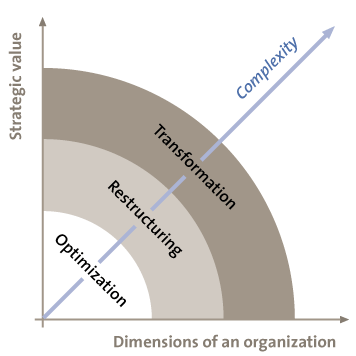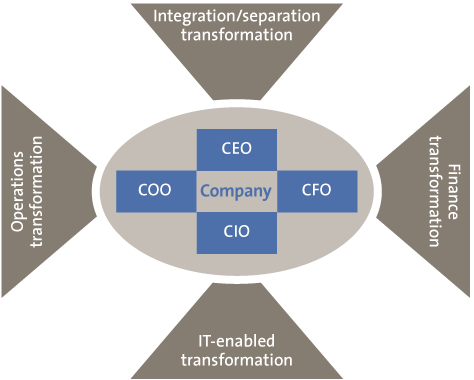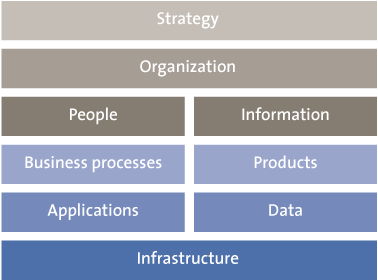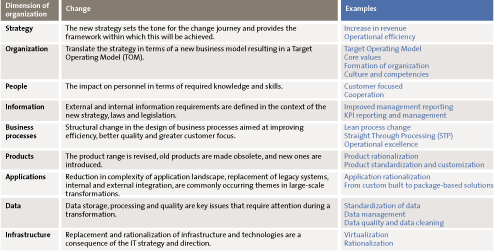Companies, now more than ever, are under continuous pressure to demonstrate improved performance. Government regulations, price pressure, lack of trust, critical shareholders and strategic objectives are increasingly triggering the need for structural changes in daily business operations. The transformation is born!
This article is about transformation, its shapes and forms. We look at transformation through the eyes of midsize and large corporations, and analyze the journey these companies must go through to achieve the objectives of the transformation. If enterprises succeed in prevailing over the many bumps and setbacks on this journey, the transformation will lead to a new and stronger position in the market place in which they operate. In this article, we provide a definition of transformation and describe the various types that exist. We also outline which dimensions of the organization are impacted by the transformational change. Finally, we support our viewpoint with practical examples.
Transformation: a definition
Ask ten people to describe a business transformation and you will get ten different answers. Most describe it in terms of ‘business related change’, but what it exactly encompasses, is not clearly defined. It is not strange that the term is so commonly misused, even though the need for transformation is greater now than it has been for years.
Many examples of “true” business transformations can be given. In all cases, however, the relationship between change and transformation should be delineated. Let’s first identify what cannot be classified as a transformation. A change arising “bottom-up”, initiated because the daily business is inefficient or needs to be improved, is not a transformation but rather an optimization. An implementation of an IT system is, in itself, not a business transformation because it only affects part of the organization and only yields a limited strategic advantage. In our opinion, a transformation should always be initiated upon a strategic (burning) platform. This means that a transformation will only be partially successful if implemented from the bottom-up or when relevant for only a part of the organization.
We view the following definition as most suitable:
“A large-scale business transformation is characterized by an intervention from senior management, driven by situational factors, technological or internal changes that impact all dimensions of the organization, with the long-term goal of increasing the performance of the entire company.”
The most striking transformations often stretch several decades as was the case with IBM. The company originally focused on clocks and typewriters in the early twentieth century. As the years passed, it responded so well to the rise of the computer that it is still considered in the present age as a leader in the domain of “business machines”. Nokia is another good example. Formerly known for paper, rubber and cables, it gradually transformed itself into a mobile communications giant. These organizations are continuously adapting, driven by a keen vision and clear business strategy, to (re-)create their future through structural transformation.
If transformation can be characterized, as outlined above, as a (continuous) intervention by senior management, it is always strategically significant because the performance of the company will progress up to a higher level. Such interventions may be imposed via external causes such as a government mandate. A good example is the separation of a large international financial institution in Europe into a separate bank and an insurer. A self-initiated, but EU determined strategic change where the company wants to reposition itself in the market.
This brings us to the question of what change actually is and when serious change is involved, whether or not it qualifies as a transformation. In our opinion, a change can be characterized as structural modifications that cannot be reversed without cost. A change becomes a transformation when all dimensions of the business are impacted and the change has a significant strategic objective (see Figure 1). A transformation is further characterized by a high level of ambition and a substantial gap that must be bridged between the current and future business state. It represents a fundamental discontinuity in the current business operations.

Figure 1. Complexity of transformation.
Although we are aware of some exaggeration, a business transformation can be seen as the “mother of all projects”. Companies that are involved in a business transformation consider this to have the highest priority and it is their main focus besides the normal ‘going concern’ activities. The company has one key strategic theme to focus on and that is the transformation.
In addition to the elements mentioned in the transformation definition and the characteristics above, there are some significant factors that determine how large and complex the transformation will be:
- Geographic: The more countries and time zones that are involved, the greater the complexity of the transformation will be in terms of requirements, communication and time differences.
- Scope: The number of business units and employees involved will influence the complexity as well.
- Stakeholders: The number of “stakeholders”, each one bringing a particular interest to the table.
- Third parties: The number of (external) third-parties involved in the transformation, such as shareholders, product suppliers and consultants.
- Knowledge: The number of disciplines that must be mobilized to realize change and the experience needed for the change to take form.
- Culture: Differences in corporate culture(s) that affect the transformation and lead to additional challenges during implementation in terms of core values, cooperation and behavior.
- Duration: The duration of the transformation and the necessity to continuously reinvigorate those involved in the transformation to stay committed.
- Technology: The number of technologies and innovations being implemented often causes unexpected problems and setbacks.
Complex transformation journeys are usually divided into phases or plateaus that have distinct milestones or stages to achieve. This has the advantage that the complexity is divided into smaller, more manageable and logically related parts. The organization also sees at the end of each plateau clear results and benefits and can learn from these steps. Usually, the planning of plateaus starts with the relatively easier chunks of work and ends with the more complicated challenges.
Types of transformations
Every business transformation is unique, but does have a generic aspect that is similar in most transformations. There are also specific aspects, mostly related to the domain of the transformation. We have identified four types of business transformations, each one triggered by a different starting point.

Figure 2. Four types of transformation with their sponsors.
- The integration/separation is addressed when a company merges with another company or is separated from another company, triggering a variety of implications for the company and its employees. The CEO is the key sponsor of this type of transformation.
- An operations transformation involves a fundamental change of all core processes of the company and the resources deployed within the core processes. For example, it might be an organizational transition from a supply-oriented organization to a customer-focused organization. The COO is the key sponsor.
- A finance transformation involves substantial changes in the structure of the financial processes (starting at the source through to the reporting), the organization, and the systems within the enterprise. The CFO acts as the main sponsor. The fundamental restructuring of financial processes has an impact on all business units supplying information and thus far beyond just the finance department.
- An IT-enabled transformation is triggered by major investments in technology. Usually, technologically driven transformation impacts different business processes and thus goes far beyond just the IT department. The sponsor is usually the CIO, but depending on the impact, it may also be the CEO or CFO.
It should be clear that these types of transformations are very different from each other. Nevertheless, all of these can be described in a generic context in which corresponding organizational dimensions are affected by the transformation. Let us first examine the generic context and then move on to an example for each type of transformation.
A transformation impacts all business dimensions!
A transformation journey is never easy, and is filled with opportunities and hazards that can arise within all the dimensions of the company. Given the nature and objective of transformations, you can expect significant (internal) resistance. To transform successfully, management must dare to take risks and be persistent and consistent in its execution. The ability of management to overcome hurdles is one of the key success factors. The complexity of the transformation lies in the interdependencies between the business dimensions as shown in Figure 3.

Figure 3. Dimensions of an organization.
Each of these components will change individually and in combination with the other dimensions. As mentioned earlier, the complexity lies in the interdependencies and the relationship with the “going concern”. In other words, implementing the “change-world” alongside the “run-world” is a challenging effort that requires a lot of management attention. Clear, consistent and frequent communication is essential and should be considered the responsibility of management as well. In particular, management must communicate the “why” and “how” of the transformation, and must be able to clearly explain the strategy, future situation and the roadmap.
Regardless of the type of transformation and the domain, the generic part of the transformation involves changes across each of these dimensions. Figure 4 lists topics that can be relevant on each of these dimensions.
Figure 4. Potentially relevant issues per dimension during a transformation.[Click for a larger image]
The transformation is aimed at achieving the target operational situation for each of the dimensions in a coherent way leading to higher levels of performance.
Business Transformation in practice
Now that we have determined the context and content of a (business) transformation, we will explain each type of transformation using a client example or case study.
Breaking up a large international financial institution into a bank and an insurer
Before the credit crisis, an international bank and insurer combination benefited from scale and a stable revenue stream. During the crisis in 2009, the European Commission mandated the restructuring of the financial institute. This was a complete turnaround for a company that had been focused for a long time on integrating brands and other companies. The executive board decided on the separation of the banking and insurance activities and began a transformation that had a huge impact on all its operations throughout the world including the operational, legal, technological, contractual and HR domains. The complexity of this separation can be illustrated by considering the scope of 60 countries and 150 business units and the time constraints under which this transformation had to take place (about two years). A multidisciplinary team was formed to accomplish this complex operation with the help of many stakeholders around the globe and guided by external advisors.
The “License” of a mid-sized retail bank
This case involves a company that is a retail and investment bank for wealthy individuals. To position its new strategy, the executive board selected two themes, “License to Grow” and “License to Operate”. The combination of these two themes had a huge impact on the entire organization and brought about large-scale changes from top to the bottom in the organization. In particular, it involved changes in the responsibilities of account managers and administrative personnel. In addition to cultural and behavioral changes, the “Operational Transformation” resulted in widespread changes in the core banking processes, IT systems and the corresponding organizational departments. Within the IT landscape, applications and infrastructure were outsourced and IT services professionalized. The transformation was phased over a period of four years and is now in the final phase.
Financial transformation within the international division of a large retail bank
Ten years ago, an IT-based project was started to establish a global financial technological infrastructure. About seven years ago, the CFRO engaged an external advisor to review the program in terms of ambition and objectives. The aim was to gain a common perspective of what steps had to be taken but this time giving Finance the lead. Developing a vision and setting the right goals and the appropriate level of ambition that was necessary for a global roll out of a common standard now became a priority. One of those goals was to bring all the regional CFO’s into line as quickly as possible. An outcome of this action was that the finance function was changed. Financial processes were changed in all countries. New systems were purchased which replaced old ones. Finally, it resulted in very different set of competences of employees both centrally within Finance as in the local countries. As a result, IT regained its previous role, that of a facilitator.
“IT driven” transformation of a large lottery company
A large lottery organization had chosen to outsource its operational processes and entire IT landscape. This was due to problems arising in the existing complex infrastructure and the new opportunities offered by Software as a Service (SaaS). The transformation was divided into two parts. First, setting up the new logistical processes and SAP based logistics system at the service provider. Second, the modifications of the lottery organization and processes to align with the new situation in which the service provider plays a role.
The IT enabled transformation has led to a dramatic change in organizational structure and a different type of IT service and support. This change affected not just the organization of the lottery. Changes were also necessary for the processes and systems for the 8000 distribution points.
Think before starting the transformation
The moment before starting a transformation is extremely important. For many companies, creating the right prerequisites before embarking on a significant transformation is key. Failure to thoroughly consider the transformation “readiness” drastically reduces the chances of success. Experience shows that during the transition there is limited opportunity to fill in the missing prerequisites. At the very least, this leads to significant delays in most cases.
Tip 1. Do we understand the transformation?
Transformations are characterized by a strategic context and focus on the structural improvement of all organizational components. Determine the type of transformation and create insight into the complexity. An “impact assessment” contributes to understanding the required change within each dimension of the organization.
Tip 2. Is the goal clear enough?
Ensure that the future (To-Be) situation is clear for all stakeholders. Confusion about where the company is going rarely results in the right course of action and outcome. It is important to outline and describe the future and to make it sufficiently concrete so that those involved can work towards achieving it and answer the question: “What’s in it for me?”.
Tip 3. Are we ready?
The most important question at the start of the transformation process is: are all prerequisites addressed and in place? This is a very different question from: are the risks identified? The first question is often confused with the second, which results in a large chance of failure. The prerequisites are the crucial starting points required for successful change. Prerequisites can have different perspectives, some examples include:
- Is it clear who the key stakeholders are? Are they involved? Is the governance set up properly? If is it clear to everyone how the transformation will take place and what their role is? Are the expectations sufficiently clear in terms of results, finances, and completion time?
- Does the organization have sufficient capacity to change and does it have the relevant experience? To what extent is the organization mature and familiar enough with large-scale and complex change programs? In other words, does it have the right skills to complete the tasks? For an organization that is not sufficiently “mature”, it is advisable to seek external assistance both on the business side and the IT side.
- Is a mature architecture discipline being used to guide the change process and to manage the complexity and risks?
- Has a readiness assessment been conducted? Most transformations that fail only provide an “after-the-fact” evaluation from which lessons can be learned. Such evaluations are commendable, but it makes more sense to perform a readiness assessment beforehand to determine how “ready” the organization is to start the transformation.
Tip 4. Sell it to all involved!
If the time is ripe for the transformation to start, then the objectives and journey ahead need to be communicated explicitly throughout the entire organization. Assigning proper roles and responsibilities is of great importance. This must preferably be done in combination with a concrete view on the future state so that people relate to it and feel committed.
Conclusion
Not every change is a transformation. A transformation is characterized by the scope, complexity and strategic value, but mainly by the fact that it impacts the entire company. Only then is a change also a transformation!
Each transformation takes place in a context where the elements that are changing are similar. Nonetheless, every transformation stands by itself. Fortunately, these can be classified into four different types: the integration / separation transformation, the operational transformation, the financial transformation, and finally, the IT enabled transformation. Make it explicitly clear what the transformation is trying to achieve and do so in such a way that it gives everyone a sufficiently clear picture of the future situation.
Before starting each transformation, it is important to understand the complexity it entails and what the impact will be on the various business units and components of the organization. Ensure that the prerequisites are properly addressed to ensure that the transformation has a higher chance to succeed. If the conclusion is that the prerequisites are insufficiently in place, it is recommended that it becomes the highest priority to ensure they are addressed before the transformation begins.
Transformations that are done right can bring major benefits to the organization, repositioning them in the market place, securing a solid future and market share and sometimes even projecting the company to market leader and example for all others to follow.





